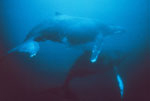Ocean Acoustics Program
Federal Task Force on Anthropogenic Sound (JSOST 2009) [pdf] |
|
|
|
The NOAA Fisheries Acoustics Program is investigating all aspects of marine animal acoustic communication, hearing, and the effects of sound on behavior and hearing in protected marine species. Specifically, the program is:
- Developing acoustic exposure policy guidelines for NOAA.
- Funding research in a variety of areas to address critical data needed to improve and expand these criteria.
- Leading efforts to develop a global passive acoustic noise-monitoring network [pdf] in key marine environments around the world.
- Continuing to work cooperatively with the shipping industry to address the emerging issue of shipping noise and marine mammals following our international symposia held in 2004 and 2007.
- Providing technical analysis for NOAA Incidental Take Authorizations and Biological Opinions involving human sound sources based on the best available marine mammal acoustic science. (See Bibliography).
- Contributing to public education by providing current information on Hot Topics and Frequently Asked Questions as well as links to educational sites, such as DOSITS
 , related programs, and reports on marine acoustic issues.
, related programs, and reports on marine acoustic issues.
More Information
- Additional Resources
- Bibliography
- Listen to Ocean Sounds
- Ocean Sound Background Information
- Publications
- Shipping Noise
- Sponsored Research
- Sonar
